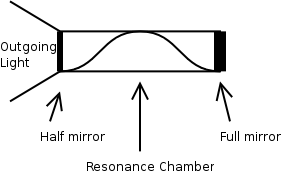I just discovered Pink Floyd.
Yeah, I'm behind the times. (My tastes have crept out in both directions from the late 1950s/early 1960s over the years; in the past I just recently got into pre-Equal Temperament (Bach) music, and I just got into the late 70's/early 80's apparently. Disco really impeded my 70s exploration, but I've discovered there was more to 70s pop then disco and disco wannabes. Sometime around 2025 I should catch up to, and subsequently pass, the present.)
 A
resonance chamber is filled with some substance and "stimulated" in
some manner so it wants to release photons. The photons a substance
releases will be of certain frequencies corresponding to the
substance's emission spectrum. The chamber is an integral multiple of
of the wavelength that you desire.
A
resonance chamber is filled with some substance and "stimulated" in
some manner so it wants to release photons. The photons a substance
releases will be of certain frequencies corresponding to the
substance's emission spectrum. The chamber is an integral multiple of
of the wavelength that you desire.